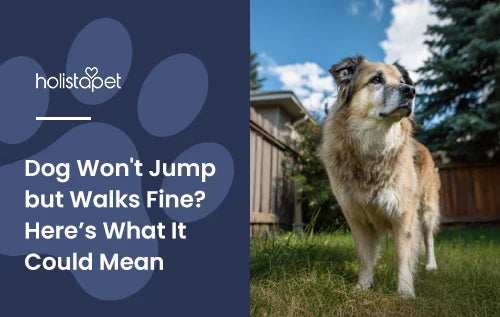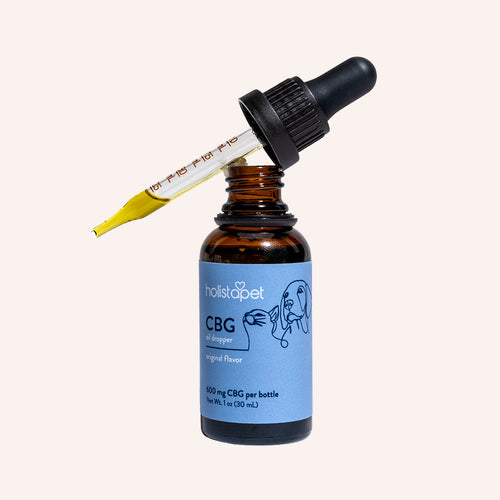Your dog won't jump, but walks fine, and it leaves you scratching your head. They can strut around the house without missing a beat, but a leap to the couch feels impossible. It looks quirky at first, but the hesitation often has a real reason.
Dogs communicate through actions more than sounds. A sudden refusal to jump while still walking could mean soreness, swelling, or just plain worry. Each clue matters when it comes to your pup's well-being. Spotting the change now gives you a chance to figure out what's wrong and help your furry friend feel better.
Why Your Dog Suddenly Refuses to Jump but Still Walks Normally

A dog that walks fine but refuses to jump is sending a clear message. That hesitation can come from several sources. Discomfort in the joints, soreness in the back legs, or a small injury may hold your pup back. Worry, negative thoughts, or past experiences can also factor in.
The change happens quickly, and it can feel strange when a once-bouncy pooch suddenly plants their paws and stays grounded. Even if their stride looks normal, the stop at the couch or car seat means something has shifted. Noticing this sudden change gives you an early chance to figure out the cause and get the right support from a veterinarian.
Physical Reasons Dogs Won't Jump
When a dog suddenly refuses to jump but still walks, their body often tells the story. Even if they look fine while strolling, certain physical issues can block them from pushing off the ground. These conditions range from stiff joints to sore muscles and can appear at any age or breed. Here are the most common physical reasons:
- Joint Pain and Stiffness
- Arthritis and Swelling in Dogs
- Hip Dysplasia or Other Structural Issues
- Spinal Cord or Back Problems That Limit Jumping
- Muscle Strain or Minor Injuries
Joint Pain and Stiffness
Joint discomfort and stiffness can keep a dog from jumping, even when walking looks fine. The leap requires strength, balance, and confidence, and sore joints make that effort tough. This often shows up in senior pups, but younger dogs can struggle, too, especially larger breeds prone to joint issues.
Your pooch may hesitate at steps, furniture, or the car because of the pressure on their hind legs. Stiffness in the joints slows them down and makes sudden movements uncomfortable. A vet checkup can help determine the cause and guide proper treatment that restores your dog's ability to move with ease.
Arthritis and Swelling in Dogs
Arthritis often shows up as swelling and tenderness in the joints, and it can stop a dog from jumping. Even though your pet may still walk, the extra force needed for a leap puts stress on sore areas. Elderly dogs tend to face this issue more often, but it can occur in younger breeds as well.
You may notice your pooch avoiding stairs, slowing down on walks, or shifting their weight away from the back limbs. These small changes signal joint trouble that makes jumping tough. A physical exam and additional tests from a veterinarian help identify arthritis early and guide the best course of action.
Hip Dysplasia or Other Structural Issues
Hip dysplasia and other structural problems can limit a dog's ability to jump while leaving normal walking intact. This condition affects how the hip joint fits together, which leads to irritation and reduced mobility. Larger breeds are especially prone, though any canine can face these challenges.
A pup with hip dysplasia may show stiffness in the hind legs or a reluctance to climb. Over time, the strain on the bones and muscles makes high-impact activities like jumping uncomfortable. Veterinary care, X-rays, and treatment help determine the severity and guide steps that reduce discomfort and support good health.
Spinal Cord or Back Problems That Limit Jumping
A dog that won't jump but still walks fine may be dealing with a spinal cord problem. Conditions like intervertebral disc disease (IVDD) can put pressure on the spine and limit movement. Even if the limbs look normal, the back may not handle the force of a leap.
You might notice your dog stopping short at furniture, lowering their head, or showing stiffness in the back limbs. Some canines may even display behavior changes, such as avoiding play or high-impact activities. A vet can perform tests, including X-rays, to determine if the spine needs professional care.
Muscle Strain or Minor Injuries
Simple injuries and muscle strain often explain why a dog won't jump. A slip on slick floors, rough play, or sudden twisting can irritate the muscles without stopping your pup from walking. Jumping, however, puts extra demand on sore areas, making them avoid the movement.
Canines with muscle strain may show subtle signs like hesitation, slower movement, or favoring one side. These injuries usually heal with rest, reduced physical activities, and proper veterinary attention. A quick check by a small animal veterinarian helps rule out bigger problems and guides the best course of action.
Behavioral Reasons Dogs Avoid Jumping
Dogs can also stop jumping because of emotional or behavioral triggers. Even if their legs work just fine, a past bad experience or a simple fear can change how they react to climbing or leaping. Here are the most common behavioral reasons:
- Fear, Anxious Behaviors, or Negative Experiences
- Lack of Confidence or Nervousness About Heights
Fear, Anxious Behaviors, or Negative Experiences
A dog may avoid jumping because of fear or anxious behaviors tied to a bad experience. A slip from furniture, a fall from the car, or even loud noises near a jump spot can stick in their memory. Even if the body feels fine, the mind may say no.
You might see your dog pacing near the couch, whining, or showing worried thoughts before trying. Some will even freeze at the base of the stairs or refuse to follow through. With patience, reassurance, and gentle training, many dogs regain trust and return to normal jumping habits.
Lack of Confidence or Nervousness About Heights
Some dogs hesitate to jump simply because they feel nervous about heights. A small pup looking up at a tall couch may see it as a challenge, even when their body is strong enough. Older dogs can also lose confidence after a slip or trouble balancing.
This lack of trust shows up in small ways. A dog might paw at furniture but refuse to leap, or circle around as if weighing the risk. These signs reflect worry more than physical discomfort. With encouragement, safe spaces, and practice, many pups regain their confidence and handle heights with ease.
Age-Related and Weight Factors
Age often changes a dog's ability to jump, even when walking still looks normal. Seniors may slow down because their joints stiffen or their muscles lose strength. Jumping demands quick power, and that burst becomes harder with time.
Excess weight adds another layer of stress. Carrying extra pounds puts pressure on the back legs and joints, making leaps uncomfortable or risky.
A balanced diet and steady physical activities help maintain a healthy weight and keep mobility strong. Of course, regular veterinary care is a must. It gives senior dogs and larger breeds the support they need to stay in good health.
Signs It May Be a More Serious Health Issue
A dog that won't jump but still walks fine may show other signs that point to something more serious. These clues often appear alongside the hesitation and hint at deeper health conditions. Here are the most common warning signs:
- Stiffness, Whining, or Reluctance to Climb Stairs
- Appetite or Mood Changes Linked to Discomfort
Stiffness, Whining, or Reluctance to Climb Stairs
A dog that avoids stairs, whines, or moves stiffly may be signaling more than simple hesitation. Walking on flat ground might still look normal, but the extra effort of climbing or jumping reveals hidden soreness. These changes often appear slowly, making them easy to miss at first.
Watch how your dog behaves at home. Do they pause before stairs, hesitate at furniture, or show agitation when moving? These signs suggest discomfort that needs veterinary evaluation. Physical exams and diagnostic tests help determine the cause and guide the best course of treatment for your pet's comfort.
Appetite or Mood Changes Linked to Discomfort
When a dog won't jump, changes in appetite or mood can be telling signs. A pet that suddenly eats less, turns down treats, or seems withdrawn may be struggling with soreness or hidden health problems. These shifts often come quietly but speak loudly about how your buddy feels.
Mood changes can include less play, more rest, or even irritability. Some dogs show behavior shifts like avoiding contact or hiding. If these patterns occur along with hesitation to jump, they point to a need for veterinary attention. A vet can perform tests and suggest proper treatment to reduce discomfort.
Natural and Supportive Remedies for Dogs That Avoid Jumping
When a dog avoids jumping, supportive care can bring comfort and restore confidence. Natural options often fit well into daily routines, helping ease soreness or worry without making life complicated. A few thoughtful changes in diet, supplements, and calming aids can help improve your dog's mobility and mood. Consider the following options:
- Joint-Support Supplements for Mobility (Glucosamine, MSM, Chondroitin, Turmeric). These ingredients support cartilage, muscle, and joint function. They work together to help ease soreness, reduce stiffness, and help your pooch stay active. Many senior dogs benefit from a daily wellness product with these natural compounds.
- Anti-Inflammatory Diets and Proper Nutrition. A balanced diet rich in whole foods can help reduce swelling and tenderness in the joints. Choosing foods with omega fatty acids, fresh vegetables, and quality proteins supports overall good health. Keeping your pet at a healthy weight also lessens stress on the back legs.
- Calming Aids for Anxiety-Related Jumping Issues. Some dogs skip jumps because of anxious behaviors or a past bad experience. Calming products help reduce worried thoughts and restore trust in movement. These aids can make furniture, stairs, and other jump points less intimidating.
How HolistaPet Can Help

HolistaPet provides pet-safe wellness products made only with natural ingredients. Every item is vegan-friendly, non-GMO, gluten-free, and third-party lab tested. These therapeutic products are also vet-approved and proudly made in the USA, giving pet parents peace of mind when caring for their dog. Choose from our:
- Joint Support Soft Chews for Mobility Relief. Found in our Mobility Collection, these chews combine chondroitin, MSM, curcuminoid, and turmeric. They support nimble joints, reduce stiffness, and promote an active lifestyle. Each bag contains 30 vegan-friendly chews without gluten or dairy, perfect for older dogs who need daily support.
- Calming Chews and CBD Oils for Fear or Discomfort. Our Calming Collection includes CBD soft chews and oils that help ease anxious behaviors. The chews come in peanut butter flavor with 5mg, 10mg, or 20mg of broad-spectrum CBD per treat. The oils deliver precise dosing through a dropper, making it simple to add to food or water. Both options help our canine friends feel calm and steady.
Preventative Measures To Keep Dogs Mobile and Comfortable
Keeping your dog mobile starts with simple habits that protect joints and support long-term wellness. Small steps in diet, exercise, and veterinary care help reduce discomfort and keep your pet active. These measures work best when started early but benefit senior dogs, too:
- Maintaining a Healthy Weight. Extra pounds put strain on bones and joints. Feeding a balanced diet and avoiding excess treats helps prevent weight gain and supports good health.
- Low-Impact Exercises to Support Joints. Gentle walks, swimming, and short play sessions build strength without stressing the body. These activities keep muscles strong and reduce stiffness in the limbs.
- Early Joint Care and Regular Checkups. Routine veterinary care and diagnostic tests spot health issues before they grow worse. Early treatment reduces soreness and helps your dog stay active with less discomfort.
Final Thoughts - Dogs Who Won't Jump but Walk Fine
A dog that won't jump but still walks fine often signals a deeper reason, whether physical or emotional. Spotting those changes early and seeking veterinary help makes a huge difference in protecting your pet's comfort and mobility. Every sign matters, from stiff joints to behavior shifts, and your response shapes their quality of life.
HolistaPet offers natural, safe, and effective wellness products designed to support dogs through these challenges. From mobility chews that help ease stiffness to calming aids that may reduce anxious behaviors, each product is carefully crafted with pup-friendly ingredients. Supporting your furry bestie with professional care and the right daily routine helps them stay active, happy, and confident for years to come.


 CBD Oil for Dogs - Fast Acting
CBD Oil for Dogs - Fast Acting
 Chicken Flavored CBD Oil For Dogs - Easy Dose
Chicken Flavored CBD Oil For Dogs - Easy Dose
 Salmon Flavored CBD Oil For Dogs - Highly Rated
Salmon Flavored CBD Oil For Dogs - Highly Rated
 CBG Oil for Dogs and Cats - Loved by Thousands
CBG Oil for Dogs and Cats - Loved by Thousands





Leave a comment
All comments are moderated before being published.
This site is protected by hCaptcha and the hCaptcha Privacy Policy and Terms of Service apply.